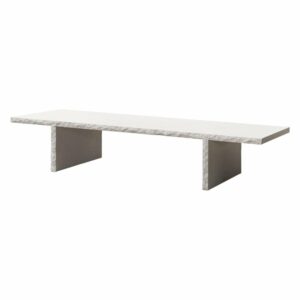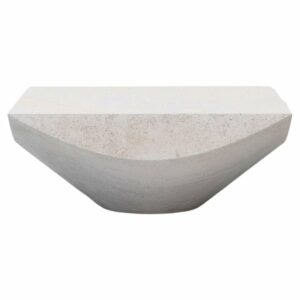
Fran Silvestre

Fran Silvestre is one of the most prominent Spanish architects of recent years. Born in Valencia, he graduated with top honors in Architecture from the Polytechnic University of Valencia (UPV) and in Urbanism from the University of Eindhoven, Netherlands. In 2016, he obtained a doctorate with honors (CUM Laude) from the UPV.
After specializing in the Netherlands, where he collaborated with the prestigious MVRDV studio, he moved to Oporto in 2002 to work alongside the globally renowned Álvaro Siza, who has been awarded the Pritzker Prize and honorary doctorates from various universities. This experience with Siza was definitive in his formation, assimilating the spatial and luminous sensitivity of the Portuguese master.
In 2005, he founded his own studio, Fran Silvestre Arquitectos, in Valencia. Since then, he has developed a prolific career that has earned him numerous recognitions nationally and internationally. Among his influences is also the sculptor Andreu Alfaro.
Fran Silvestre’s projects are characterized by serialization, modulation, attention to detail, and masterful use of light. Standout works include the Alfafar Art and Auditorium Center (2008), the Atrio House in Valencia (2009), the Cliff House in Calpe (2011), and the recent Balint House in Bétera (2014) and House among the Pinewoods in Valencia (2016).
These and other works have earned him awards such as the MHK Berlin Prize, the Nagrade Hise Prize, the Red Dot Prize, the Spanish Biennial of Architecture and Urbanism Prize, and the IFCC New York Prize. His work has been widely published in specialized media.
1. You are coming from a family of engineers and inventors. Could you tell us your first memory related to architecture? How did your journey and passion for building spaces start?
From a young age, I was fascinated by creative work but also had a strong interest in science. Perhaps it was this combination that led me to choose architecture. It was somewhat of a calling—I knew exactly what I wanted to do. As a child, I built many things and was especially drawn to those that served a practical purpose.
2. Has there been a defining moment in your career to pursue architecture? An event that has changed the flow significantly?
My great-grandfather, Valentín Silvestre, was the inventor with the most patents in the second half of the 19th century. The relationship between engineering, something I have always been passionate about, and art, which I also found very interesting, was architecture.
3. How do you usually start a project? Do you start with an image, with a keyword, or with a specific material?
We work as a team from the beginning of each assignment, delving into the initial concepts and ideas, which for us are the soul of the project. For each program we prepare three different design proposals, based on the same client wish list, the same plot, and the same regulations.
These three different ideas that compete within the studio, usually appear through making three different mock-ups. It is quite a laborious back and forth work until the project is fine-tuned. For us it is a conceptual challenge that leads us to improve and pushes us to always go a little further to get out of our comfort zone. For our clients, knowing that they are going to choose and be part of the design process is also a point of confidence.
4. You mention “the sublimation of the every day” as a concept that motivates you. Could you please elaborate on this idea? How do you try to achieve that in your projects?
In my practice, elevating the everyday through architecture involves creating spaces that enhance daily life. This means designing environments that are not only functional but also aesthetically uplifting, ensuring that each architectural element contributes to a cohesive and enriching user experience.
The sublimation of the everyday is a question that encourages and motivates us. We always like to improve the environment in which we live, so being able to enjoy living in a home, but at the same time being part of an artistic expression, is very important to us. Trying to make something that may seem banal, something that we do every day, become something we do every day, becomes something special.
5. Which architects and designers do you appreciate the most?
My influences and references in architecture have been deeply marked by two key figures: Álvaro Siza and Emilio Tuñón. Working with Álvaro Siza has been essential to understand architecture as an artisanal process, where every detail and every decision reflects a deep commitment to context and functionality, always maintaining a connection with Mediterranean tradition in an innovative way. This experience has enriched my approach towards creating spaces that dialogue with their environment in a subtle and respectful way.
On the other hand, I find Emilio Tuñón’s work as a whole, as well as his trajectory, impressive. I believe that Tuñón has developed a great capacity for synthesis and abstraction that can be perceived in his works, in his architecture, and for us, sincerely, he is a great reference.
6. What do you think architecture needs more of in our times?
We believe that, years ago, design was competing with added value, now sustainability is unquestionable, and we think that the relationship between architecture and health is what lies ahead.
7. Thinking about the history of design and our contemporary times, how do you think the design industry/interior design has changed over the last decade?
We think that architecture is changing a lot lately. We believe that systematization is altering the way we build, and this evolution is closely related to the world of assembly and furniture. Currently, construction and the the accompanying architecture are in a process of transformation, for which we have formed a new company called NIU Houses in which we are immersed now.





8. What has been one of the hardest-learned lessons in your practice?
The resilience. Resistance to change is one of the determining factors in the architectural project process. This resistance exerts its force on our ideas, but also on ourselves and on all the people involved in this process. This is where the dialogue takes on an even more important meaning. The projects we carry out are a constant round trip where the change of course is always present. Being able to assimilate and incorporate these changes as one more work tool is what allows us to achieve an exact answer to the challenges that we face and to be able to obtain satisfaction from our work.
9. Do you have a mantra that encapsulates your taste in architecture or design?
We always try to have the pursuit of effective beauty as our premise. On the one hand we talk about beauty because it is something that motivates us, a desire that moves us, and on the other hand, efficiency, because in the end we have to make things work properly. This is a question that for us is indispensable in our constructions.
We are also influenced by something that we live in our environment since our studio is now in the Espai Alfaro, the former studio and workshop of Andreu Alfaro, one of the most important sculptors of the Spanish twentieth century, a space made up of several buildings structured around a large courtyard, populated by large sculptures, which make the place a great oasis of creativity. Andreu, as we have previously mentioned about Tuñón, was characterized by his impressive capacity for synthesis. He could take works from antiquity and be able to synthesize them in a single stroke. We believe that this capacity for synthesis is something that also influences us in our day-to-day work. Working in a 7000m2 space where the sculptor’s workshop was located allows us to live surrounded by culture, which positively contaminates our work. Also using his old workshops to make scale models and prototypes has conditioned our professional practice.
Another issue that encourages and motivates us is the sublimation of everyday life, as we say before. We think that all this has generated a “way of doing” that perhaps is perceived with a lot of identity, although for us, the style, which would be the handwriting, is not as important as the concept, what we want to convey with each of the projects
10. What is the source of your inspiration? How do you fuel your creativity?
We like to think with our hands. There is a very interesting book by Juhani Pallasmaa called The Hand that he thinks has inspired us a lot in this sense. Creating new volumes that we find attractive and interesting to inhabit. This is a methodology that works very well for us.
11. What are your 3 favorite pieces from the Philia Collection?
-
Bourgogne Stone Coffee Table Fruste by Frederic Saulou
€11,00012. Finally, what are your upcoming projects? Anything you’d like to share or add to the interview?
There are many challenges ahead. We’re working on projects in a wide variety of locations, and we’re already present on five continents. For us, each of these projects is unique, whether it’s hotels in Miami, Porto, Koh Samui, or El Salvador, or projects in Florida, Egypt, and Saudi Arabia. We’re particularly motivated by those that involve new approaches to sustainability.
However, the most important project right now is our own studio, the team, and the people who make it up. We’re currently remodeling the facilities, and it’s a very exciting time for all of us.





